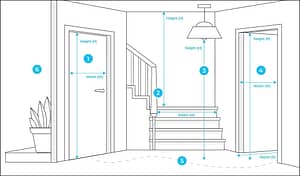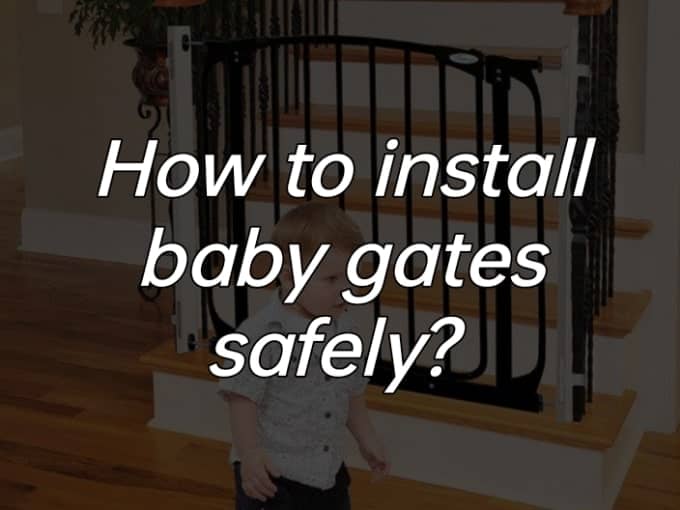Table of Contents
ToggleAs your baby starts to become more mobile around the house, it’s important to make sure that all areas of your home are safe for them. Installing baby gates is one way to do this and minimize any potential risks.
But before you start installing gates throughout your home, there are a few things you need to know!
In this blog post, we’ll be guiding you through why installing baby gates is so important and providing helpful tips on how to install baby gates safely and effectively – everything you need to child-proof your home with peace of mind!
How to install baby gates safely?
- Measure the doorway or stair width.
- Choose Walls.
- Choose the right type of gate.
- Follow the manufacturer’s instructions.
- Test the gate.
- Check the gate regularly.
- Teach older children to use the gate correctly.
Now Let's dig deep into these steps.
Step 1. Measure the doorway or stair width:

Before you can even consider purchasing a baby gate, it’s essential to measure the width of the doorway or stairway you intend to install the gate.
You should also note down the height and depth of both sides of any opening where you plan on installing a gate.
This will ensure that you are buying a gate with the correct size so that your baby is safe from any potential harm.
Step 2. Choose Walls.
When installing a baby gate, it’s important to choose surfaces that are strong and stable. The best surfaces to install a gate on are flat walls or posts that can withstand the pressure of the gate. Avoid installing it on weaker structures such as drywall as this could be dangerous for your child.
Step 3. Choose the right type of gate:
There are various types of baby gates available in the market to cater to different needs and home setups. Here are some of the most common types:
- Hardware-mounted Gates: These gates are mounted into framing inside the walls of your home. They are extremely sturdy and ideal for dangerous areas like the top of the stairs.
- Pressure-mounted Gates: These types of gates are held in place by pressure against the door frame or walls. They are easy to install and remove, making them a good choice for areas where there’s less risk of your child falling, like between rooms.
- Freestanding Gates: These gates stand on their own and are good for open areas or irregular spaces.
- Retractable Gates: Retractable baby gates can be pulled across or pushed back as needed. They’re versatile and can be used in various spaces throughout your home.
- Extra Wide Gates: These gates are designed for wider doorways or open spaces in your home. They are often hardware mounted for extra security due to their size.
- Fireplace Gates: These are used to protect your child from the fireplace area. They’re usually extra wide and can be configured in a variety of ways to keep your little one safe.
- Playpen Gates: These gates are modular and flexible. They can be used to create an enclosed play area or can be used as a barrier to block off large sections of a room.
- Outdoor Gates: These gates are designed for outdoor use and can be used to block off decks, patios, or other outdoor areas. They come in various materials like wood or metal to withstand weather conditions.
Step 4. Follow the manufacturer’s instructions:
Once you’ve chosen the right gate for your needs, it is important to read through all of the manufacturer’s instructions for installation. This is to ensure that the gate is installed properly and securely, as improper installation could pose a safety risk.
Step 5. Test the gate:
Before using the gate, it’s important to test it out first. Push down on the top of the gate or tug on it from both sides to make sure that it is firmly in place. If the gate moves or wobbles, then it may need to be tightened further or even replaced if necessary.
Step 6. Check the gate regularly:
It’s important to check your baby gate regularly after installation to see if any parts are loose or damaged and replace them if needed. This will help keep your baby safe and your home secure.
Step 7. Teach older children to use the gate correctly:
If you have older children in your home, it’s also important to teach them how to use the baby gate properly. You should explain that they need to open and close the gate carefully every time they pass through it, and not climb over or under it, as this could cause the gate to become unstable.
Installing baby gates in your home is one of the most effective ways to keep your baby safe and secure.
Following these steps can help ensure that you install them safely and correctly so that they provide you with peace of mind.
Don’t forget to check the gate regularly for any signs of wear or tear and replace it when necessary. Your baby’s safety is just as important as their health, happiness, and well-being!
By following these tips and taking the time to properly install a baby gate in your home, you can keep your little one safe while assuring yourself of knowing that they are secure at all times.
Before read how to install gates safely without damaging walls? We recommend you to read this post: Do baby gates damage walls ?
How to install baby gates safely without damaging walls?
Step 1. Use no-drill baby gates:
While traditional baby gates require drilling into walls or door frames, there are no-drill alternatives available in the market. These no-drill gates utilize pressure or tension systems to securely fit in the desired doorway or stairway. Such gates are ideal for renters or individuals who don’t want to leave permanent holes in their walls.
Step 2. Opt for adhesive hooks:
Some gates come with adhesive hooks that can be attached securely to the wall without drilling. Ensure that the adhesive is strong enough to withstand the pressure exerted by the gate and the child. Always follow the manufacturer’s instructions when using adhesive hooks to ensure safety and prevent any damage to the wall surface.
Step 3. Use gate mounting kits:
Gate mounting kits are another way to install a baby gate without causing any damage to the walls. These kits usually include a flat piece of wood or metal that can be attached to the wall using adhesive strips. The baby gate is then mounted onto this piece. This can protect your walls from damage while still providing a secure installation.
Step 4. Regularly inspect the installation:
Once you’ve installed the baby gate, ensure that you regularly inspect its mounting points. This is to ensure that there is no damage to the wall and the gate remains secure. If you notice any loosening or signs of wear, adjust the tension or replace the adhesive as needed.
By following these steps, you can install baby gates in your home without causing any damage to your walls while still ensuring the safety of your child. Just remember, the primary function of the gate is to ensure your child’s safety, so never compromise on the quality or structural integrity of the gate for the sake of protecting the wall.
Here are the types of baby gates mount and their uses:
- Hardware Mounted Gates:
Hardware Mounted Gates are attached to the surrounding walls or doorframes using screws. Due to their more permanent and sturdy nature, they are ideal for places in the house where falling could be dangerous, such as the top of the stairs. While they require more effort to install and remove, these gates provide an extra level of security.
- Pressure Mounted Gates:
Pressure Mounted Gates are held in place using tension or pressure exerted on the doorframe or walls. They are easy to install and remove, making them a good choice for rooms where the risk of falling is minimal. However, they may not be as secure as hardware-mounted gates.
- Freestanding Gates:
Freestanding Gates are independent structures that can be placed anywhere in the house. They are ideal for irregular spaces or large rooms. The gate stands on its own and can be moved easily, offering versatility in terms of placement.
- Retractable Gates:
Retractable Gates can be moved back and forth as needed, making them a flexible choice for various spaces in the house. Not only do they provide security, but they also save space when retracted, making them a convenient choice for smaller homes or rooms.
- Extra Wide Gates:
Extra Wide Gates are designed for larger doorways or open spaces in the house. They usually use a hardware-mounted system for additional security due to their size. This type of gate ensures that wider spaces in your home can be secured effectively.
- Fireplace Gates:
Fireplace Gates are used to create a safe zone around the fireplace area. These gates are typically wider and can be arranged in various ways to suit the space. The primary purpose of these gates is to keep your child safe from potential hazards associated with a fireplace.
- Playpen Gates:
Playpen Gates are flexible and modular, making them ideal for creating an enclosed play area. They can be rearranged to block off sections of a room or create a contained space for your child to play in.
- Outdoor Gates:
Outdoor Gates are designed for external use and can be used to secure decks, patios, or other outdoor spaces. They are usually made from weather-resistant materials like wood or metal. These gates provide a safe outdoor environment for your child to explore.
Each type of baby gate mount serves a specific purpose and comes with its own set of advantages and disadvantages. Choosing the right one depends on your individual needs, the layout of your home, and where you intend to use the gate.
Conclusion:
Choosing and installing the right baby gate is a crucial step in creating a safe environment for your child. From hardware-mounted to freestanding, each type of gate serves a specific purpose depending on the layout of your home and your individual needs.
By following the recommended steps for safe installation and regular inspection, you can minimize potential wall damage and ensure the most secure setup.
Always remember, the highest priority is your child’s safety, so never compromise on the quality of the baby gate. It’s a small investment for peace of mind and the well-being of your little one.



14 thoughts on “How to install baby gates safely?”